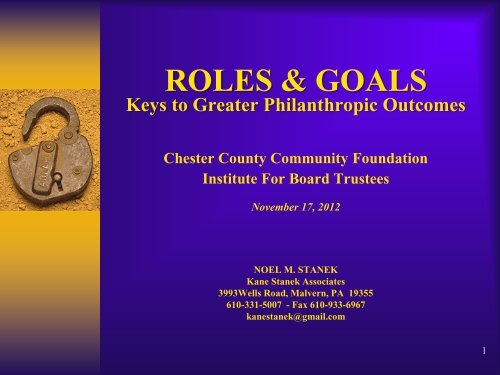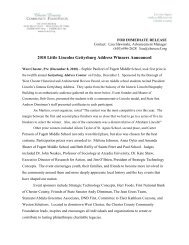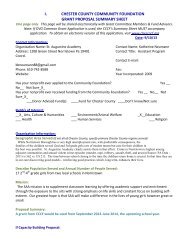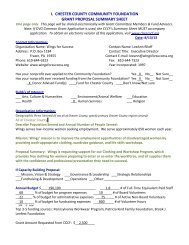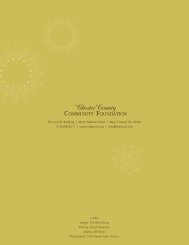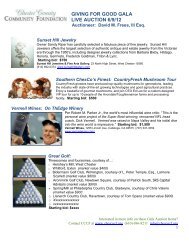ROLES & GOALS - Chester County Community Foundation
ROLES & GOALS - Chester County Community Foundation
ROLES & GOALS - Chester County Community Foundation
- No tags were found...
Create successful ePaper yourself
Turn your PDF publications into a flip-book with our unique Google optimized e-Paper software.
4. Construction des bâtiments (joindre une annexe au besoin) :Bâtiment n° 1Nombre d'étages : Superficie du bâtiment : Âge du bâtiment :Si la construction date de plus de 25 ans, énoncez tout ajout qui a été fait :Construction des murs : Toit :Planchers :Source de chaleur : Sous-sol? Oui NonAlarme contre le vol? Oui Non Si oui, de quel type : Central Surveillance Local ULC PartielBâtiment n ° 2Nombre d'étages : Superficie du bâtiment : Âge du bâtiment :S'il a plus de 25 ans, énoncez tout ajout qui a été fait :Construction des murs : Toit : Planchers :Source de chaleur: Sous-sol? Oui NonAlarme contre le vol? Oui Non Si oui, quel type : Central Surveillance Local ULC Partiel5. Les extincteurs sont-ils facilement accessibles dans tous les bâtiments? Oui NonÀ quelle fréquence sont-ils vérifiés?Les bornes et boyaux d'incendie sont-ils stratégiquement situés et accessibles? Oui Non6. Les portes sont-elles toutes munies de serrures à double cylindre avec pêne dormant? Oui NonSi vous avez répondu « Non », veuillez décrire la protection :Décrivez toute autre protection contre les incendies et le vol :Activités1. Veuillez décrire la participation totale annuelle :Veuillez joindre une copie de tout formulaire de renonciation ou médical utilisé1) Programmes locauxS'il y a des participants de moins de 18 ans, veuillez joindre la proposition pour supplément concernant lesagressions sexuelles.Programme/activité :Patinage publicN bre totaldeparticipantsN bre departicipantsmineurs(moins de18)N bred'équipes/groupesRecettesbrutes :Formulaire derenonciation signé?(Si oui, veuillezjoindre une copie) Oui NonN bre estimédeparticipantsétrangersCours de patinageBasketballLigues de hockeyLeçons de natationLigues de baseballRinguetteCurlingÉvénementsspéciauxAutre :Autre :(Ed01/13)Page 3 de 9 Oui Non Oui Non Oui Non Oui Non Oui Non Oui Non Oui Non Oui Non Oui Non Oui Non
VALUE OF BOARD• Serve as key link between organization & community.• Legitimizes the cause.• Increases the stature of an organization.• Expands philanthropic network & organizational reach.• Provides knowledge beyond the organization.• Extends resources & capabilities.• Makes meaningful gifts to serve as example to others.4
KEY POINTStrategic Focus“If you do not change direction, you mayend up where you are heading.”Lao Tzu5
CORE PRINCIPLES• To raise higher levels of philanthropy, you must focuson major gifts.• Major require face-to-face cultivation & solicitation.• Major gifts are raised by peer-level solicitors.• Board Members & volunteers are key intermediariesto reach & engage major donors.• The effectiveness of the Board & volunteer relationshipdetermines the level of fundraising success.6
ACTIVITIES & OUTCOME80% of Funds - 20% of Donors (Relationship-based)• Major Gifts, Campaigns, Planned Gifts• Requires Fewer Resources• Donor & Volunteer Focused• Lower Costs & Highest Returns20% of Funds - 80% of Donors (Arms-length)• Direct Mail, Events, Phonathons• Labor & Resource Intensive• Staff-Focused• Higher Costs & Limited Returns7
ACTIVITIES & OUTCOMEDIRECT MAIL RESULTS• 50% of donors do not renew their gifts after their firstcontribution.• A 30% attrition rate after the second gift is common, followedby a 20% attrition with each subsequent appeal.• On average, by the fifth appeal, 90% have stopped giving.• Donors stop giving because of lack of meaningful informationor the feeling that their gift is not appreciated.Burk, Penelope. Donor-Centered Fundraising.8
THE BIG CONUNDRUMWe know that…• For an organization to raise more funds, it must focuson major gifts;Yet…• Few organizations have effective major gift programs& spend little time developing relationships with majordonors.9
WHY?• Major gifts are about people, not money.• Major gifts require face-to-face, personalrelationships between the donor & the organization.• Major gifts require the active participation &support of volunteers with influence & affluence.• Major gifts require active involvement & support byBoard & organizational leadership.• Major gifts require greater levels of organizational& professional accountability & vulnerability.• Major gifts take time & commitment.10
KEY POINTDevelopment Roles"The achievements of an organization are the resultsof the combined effort of each individual."Vince Lombardi11
BOTTOM LINEManagement/Development can directly reachthe 80% of people who give 20% of funds.Board members/peer-level volunteers can directly reachthe 20% of people who give 80% of funds.Key intermediaries are essential forphilanthropic positioning & outcome.12
CLARITY OF <strong>ROLES</strong>Board members can fulfill their fundraising roles onlywhen they are aware them.Roles & expectations must be clear and fullyunderstood by both Board members & managementstaff to strengthen organizational potential & avoidconflict & dissatisfaction.13
THE BOARD AS GIVERS• Organizations should expect 100% giving from Board.• Board solicitation is best accomplished by a Board leaderwho is respected & has influence on the others.• Board giving should precede requests to external sources.• Board giving sets an example for others.• Board gifts should be evaluated in a strategic,collaborative process.• Board giving should not be taken for granted – givingis discretionary.14
THE BOARD AS GETTERS• Identify potential donors, especially at major gift level.• Evaluate prospects for ask amounts.• Provide prospect information to determine strategy.• Participate in cultivation process.• Use personal influence with prospects & donors.• Solicit prospects as appropriate.• Use own gift as example for others.• Thank donors.15
IMPEDIMENTS TOPARTICIPATION• FEAR!• Uncertain about roles & expectations.• Lack of knowledge & preparation.• Uncertain or unclear about needs.• Not fully committed to cause.• Concerns about fiscal integrity or leadership issues.• Avoidance of quid-pro-quo gifts.• Time & schedule conflicts.16
KEY POINTStrategy & Relationships“Donors do not give to institutions. They invest inideas and people in whom they believe.”Kay Grace17
OUTCOME COMPARISONSANNUAL GIVING VS CAMPAIGNS18
TARGETED STRATEGIES• Focus on Major Gifts - Major gifts account for 80% of the goal,come from 20% of donors & define success.• Focus on Individuals - Gifts from individuals account for 81%;foundation gifts for 14%; and corporate gifts for 5% of all giving.• Focus on Relationships - Donors give larger gifts because ofrelationships with the organization and/or the asker.• Focus on Targeted Strategies - Major gifts are the result ofpersonal contact, one-on-one meetings & highly targetedstrategies.• Focus on “Ownership” - Volunteers involved in fund raisingactivities give initial gifts & the majority of major gifts.• Focus on long-term giving: - Pledge periods & other opportunitiesfor giving, such as planned gifts, increase gift amounts.19
DONOR-CENTEREDENVIRONMENT1. Compelling Purpose – Specific goals & case for support.2. Effective Strategy – Structure & methods to promoteengagement & “ownership.”3. Meaningful Relationships – Cultivation, solicitation &stewardship of people of affluence & influence who cangive at a major gift level & ask others to do the same.20
DONOR EXPECTATIONS• Clear understanding of what they are supporting.• Strong & moving Case that addresses personal needs &interests.• A solid plan for meeting goal & completing the defined work.• Evidence of other support.• Evidence that their gift has impact – to feel meaningful.• Strong leadership (Board, Organization & Fund Raising).• Avenues for involvement & meaningful participation.• Opportunities for recognition.21
SPECIFIC CASE & <strong>GOALS</strong>• The Case for Support is based on the strategic direction of theorganization – be cautious about chasing money• Case should “move the heart” first & then “satisfy the head” –emotional appeal supported by a sound business plan.• The goal is defined by the Case for Support.• Goals are self-fulfilling – higher goals mean higher gifts, butgoals should be based on reality.• Goals should be supported by levels of giving matched withpotential prospects.• Goals can be benchmarked & divided into specific time-framesor purposes.• Goals are a catalyst & can encourage giving.22
CULTIVATIONCultivation is about building relationships& fostering “ownership.”• Cultivation is the process of establishing & deepening arelationship between the donor & the organization• Relationships are absolutely essential to major gifts &planned gifts.• Donors begin a relationship because of a personal, intrinsicmotivation or need to do so.• Donors continue a relationship as a result of theorganization’s ability to meet their needs & expectations.23
TYPES OF CULTIVATION• INDIVIDUAL CULTIVATION – Highest impact; ideal formajor donors, board member recruitment & key marketingindividuals.• GROUP CULTIVATION – Process of introduction but needsfollow-up on an individual basis to be effective.• EVENTS/ACTIVITIES – Introduces prospect to organization,but “host” individuals need to be assigned & key prospectsfollowed-up on an individual basis.24
<strong>ROLES</strong> IN CULTIVATION• FACILITATOR – Makes initial contact with prospect,introduces prospect to organization & participates incultivation & solicitation. (Board Member or Volunteer)• AUGMENTOR – Person representing the organization that hasinfluence on the prospect by status or position. (CEO & OtherOrganizational Leadership)• CLOSER – Individual of personal meaning & significance toprospect who participates in cultivation. (Board Member orVolunteer)• COORDINATOR – Catalyzes & organizes the process, workingwith the prospect, leaders, facilitators & assures that follow-upoccurs. (Development Officer)25
CULTIVATION PROCESS• Board & leadership participation is key.• Peer-level volunteers are critical.• Meetings work best over food.• Conversation is 80% small talk – THE “ONIONS”• Follow-up is as important as the cultivation event .• THANK, THANK, THANK!• Development Officer facilitates, moves & fosters process.26
MORE IS NOT BETTERRelationships grow one step at a time& each contact should lead into the next.When you overwhelm volunteerswith too much too do – little gets accomplished.JUST ONE THING!Never leave a meeting without the next step.27
“JUST ONE THING”• Seek advice & counsel on strategy.• Ask help with planning activities.• Identify potential prospects/askers/donors.• Assist with prospect evaluation.• Seek participation on program, task-force or committee.• Involve in direct hands-on service.• Ask to open doors & serve as “networker.”• Seek participation in community outreach activities.• Honor or recognize achievements.28
STEWARDSHIPFOSTERING CONTINUING INVOLEMENT• Always follow-up on promises!• Relationship-building is a process of ongoing communications.• Donors want to hear from us, not just when we solicit.• Donors “burn-out” because we do not make them feelappreciated or meaningful.• Donors need to know how their giving has impacted theorganization through various methods of communication.29
FINAL KEYBoard Participation“Never doubt that a small group of thoughtful,committed citizens can change the world;indeed, it's the only thing that ever has."Margaret Mead30
OPPORTUNITIES FORPARTICIPATION• Provide input on Development Plan.• Provide list of names & potential donors.• Share insights about prospects & donors.• Write thank you notes to donors.• Organize parties & other events.• Donate personal items for use at auctions & events.• Sell raffle tickets, obtain prizes, sponsorships or ads.• Place personal notes on solicitation letters.• Advocate for the organization in the community.31
OPPORUNITIES TOCULTIVATE & ENGAGE• Participate in tours & meetings with prospects.• Send personalized solicitation letters to friends.• Ask friends to donate for various purposes.• Participate in visits & presentations.• Participate in prospect evaluation sessions.• Initiate & participate in cultivation/solicitation activities.• Serve on campaign & major gift committees.• Serve in leadership role for campaign & other activities.32
“We make a living by what we get.We make a life by what we give.”Winston Churchill33
Supplementary Materials•Development Roles•Cultivation Program•Essential <strong>Foundation</strong>s of Fund Raising•Nine Keys to Building Relationships•Relationship-Based Development – Essential Characteristics•Sample Position Description – Development Officer•Sample Development Report for Board•Case & Goal Worksheet•Prospect Evaluation Table•Bibliography34
BOARD MEMBERDevelopment RolesKey intermediary with prospects & community; sets philanthropic example for others to follow.Articulates vision, plans & need for charitable support and represents and advocates for the organization in the community.Participates in and supports Development activities.Participates in the planning, provides meaningful input, and endorses the Development Plan.Identifies & provides insights about prospects and potential sources of funds.Uses personal influence to reach prospects and introduce them to the organization.Participates in cultivation activities, often serving as key link between prospect and organization.Participates in solicitation activities as appropriate.Monitors Development Program and assures compliance with policy, plans & goals.Gives generously and asks others to do the same.CEO/PRESIDENT/EXECUTIVE DIRECTORSets the course for the Development Program and inspires others to action.Serves as the leader of the Development Team, ultimately responsible for its success.Serves as the key representative of the organization with Board, fund raising leadership, donors, prospects, and the community.Develops “partnership” relationships with Board members and key volunteers responsible for fund raising, especially at the major gift level.Works hand-in-hand with the Development Officer to assure that the Development Program is moving forward according to plan and schedule.Determines organizational needs & priorities to serve as platform for the goal and Case for Support.Sets the direction and focus of the Development Program.Presents the Development Plan to the Board to engender participation & support.Educates Board members regarding their role in major gift fund raising as appropriate.Participates in cultivation activities and is able to present an inspiring Case for Support.Participates in solicitation activities as appropriate.Responsive to donor needs and interests & participates in stewardship activities designed to strengthen relationships with key donors.Willing to commit time and resources to assure the successful achievement of goal.35
FUND RAISING LEADERSHIP & VOLUNTEERSVolunteers who can both “give and get” major gifts.Volunteer leadership can be the “maker or breaker” for the Development ProgramAssists in the development of fund raising goals and strategy.Provides insights about prospects and potential sources of funds.Identifies and uses personal influence to reach prospects.Participates in cultivation activities, often serving as key link between prospect and organization.Participates, and often leads, solicitation of prospects at the major gift level.Advocates for organization in the community.Gives generously at a major gift level and asks others to do the same.FUND RAISING OFFICERManages & facilitates the Development process & fosters continuing momentum.Serves as liaison to Board, prospects, donors, & volunteers.Creates Development Plan, oversees all Development programs & operations, & is responsible for accomplishment of goals.Develops Case for Support in keeping with strategic directions.Identifies, researches & evaluates prospects.Facilitates contacts with prospects & donors.Manages & participates in cultivation activities & follow-up.Responds to donor needs & manages relationships.Develops proposals & participates in solicitations.Develops cultivation and solicitation materials & Development communications.Maintains accurate prospect & donor files.Manages gift receipt, acknowledgement & recognition.Professionally represents organization in the community.36
Cultivation ProcessThe raising of philanthropic funds is very competitive. Donors have become increasingly selective in deciding which charities they willsupport and, in most cases, support organizations with which they have a relationship. Those organizations that have established and nurturedmutually satisfactory relationships with prospects and donors are most likely to succeed.The cultivation program is the cornerstone of a relationship-based Development Program and is designed to foster and strengthen therelationship between the prospect/donor and the organization. It is the primary means of relationship-building and, for that reason, itsimportance cannot be overstated. An effective cultivation program is a requirement for major gifts, campaigns, planned giving and estategifts, as well as continued support by donors over the years. It is the role of the Development Officer to work with the Executive Director,Board members and fund raising volunteers to assure that cultivation activities are occurring on a regular basis. The Development Officer isalso responsible for maintaining and growing the relationship with the donor or prospect once it is established.INVITATION & ATTENDANCE• The cultivation process begins when an invitation is issued to a prospect or donor by a key contact person asking the prospect to attenda private luncheon or meeting. The contact person is someone who can reach and encourage the prospect to attend through their ownpersonal influence. Prospect research and evaluation helps to identify these key individuals.• For Board recruitment and major gift development, the cultivation meetings are "private" with no other prospects in attendance.Cultivation activities directed at groups of prospects are suitable for mid-level gift solicitations, but not for Board recruitment or majorgift solicitation.• There is no general rule as to which staff or Board member should attend the cultivation meeting. Effectiveness and influence are themost important criteria. Therefore, those attending the meeting should be known by or meaningful to the candidate. Most cultivationevents will include both the leader of the organization (Executive Director/President/CEO), the Development Officer and, ifappropriate, a representative of the Board as well as the person who made the initial contact, usually a volunteer, who serves as "host"for the event.MEETING ORGANIZATION• Cultivation meetings should be held at the organization whenever possible. This gives the prospect a better point of reference, enablesthe prospect to see firsthand the operations of the organization and creates a stronger identification and bond with the organization.• The best cultivation meetings are over food. Food provides a social milieu and encourages personal conversation which allows therepresentatives of the organization to get to know the prospect better, and helps the prospect feel at ease. The selection and presentationof food should be simple enough to show regard for the resources of the organization, but nice enough to demonstrate the importanceand level of respect for the guest.37
• The Development Officer or designee should manage all of the details of the event including: food, parking, directions, roomarrangements, materials, presentations or displays, and any other activity designed to assure a positive experience for the prospectand a positive reflection on the organization. In some situations, the Development Officer will need to provide transportation forthe prospect. This is actually advantageous because it offers an opportunity to converse on a more personal basis.• Although the cultivation meeting or luncheon is structured and organized, it is actually quite informal, conversational, andpleasant. At all times, the guest should always be made to feel comfortable, welcome, and "at home."• The information presented during the cultivation meetings must answer key questions for the prospect. This information may beprovided at one meeting or through a series of meetings depending upon the interests, time availability, and involvement of theprospect. When completed, the prospect should be knowledgeable of the purpose of the organization and its value to thecommunity. Furthermore, the prospect should understand what he or she is being asked to do and the importance of his or herinvolvement and support.• Whenever possible, the verbal information should be supported by written documentation, especially as it relates to finances,utilization statistics, and service trends. This information should be included in the "cultivation kit" and referred to during thediscussion process.REQUEST & RESPONSE• When appropriate, the final step of the process is to ask for acceptance of a Board position and/or a major gift, depending upon thepurpose of the cultivation meeting. The question is usually presented by the person who is most effective, usually a volunteer andthe person with whom the prospect has the strongest relationship. It should be noted that it may take several meetings and contactsto bring the prospect to this point of the discussion. The "ask" should be made only when the relationship has matured and theprospect is committed to the organization and likely to respond positively.38
• It must be remembered that cultivation is not solicitation. In many situations, the cultivation meeting is the first time that theprospect has visited the organization. Therefore, it may not be possible or prudent to request a gift or any formal involvementuntil the relationship has matured. However, it is also important to begin the process of engagement.• The Development Officer or any other representative of the organization should ask the prospect to do “just one thing.” Bygiving them something meaningful to do, it will start the process of involvement and allow for continued communicationbetween the prospect and the organization. The “one thing” could be anything from calling another prospect, inviting someoneto the organization, providing feedback on information, etc. The most important thing is to keep the lines of communicationopen and to start involving the prospect in the work of the organization. This continued involvement leads to a growing senseof commitment and a sense of ownership which is needed for major gifts and leadership recruitment.• When an ask is appropriate, the request can occur at a cultivation meeting or privately between the prospect and the solicitor atsome other location and time. This determination is based on the comfort level of the prospect and person asking, and isdifferent in each situation.• If the prospect answers the request affirmatively, he or she should be thanked immediately and formal letters of gratitude sentthe following day by both the volunteer and organizational leadership. In addition, the contact person should also be thankedfor the time and effort given on behalf of the organization.• Should the response be negative, it is the responsibility of the Development Officer to find a way to continue to build therelationship and keep the prospect involved and informed about the organization's activities. Regardless, the prospect has giventime to hear about the needs of the organization and should be thanked, as should the contact person. More than a few initialresponses to the negative have become positive after the relationship is strengthened.39
Essential <strong>Foundation</strong>s of Fund Raising, Excerpt from “Relationship Fundraising” by Ken Burnett• People give to people. Not to organizations, mission statements ,or strategy.• Fundraising is not about money. It is about necessary work that urgently needs doing. Money is the means to an end.• Fundraisers need to be able to see things through their donors’ eyes and put themselves in their donors’ shoes.• Fundraisers need to really understand their donors. If they are to understand you, you must first understand them.• Friend-making comes before fundraising. Fundraising is not selling. Fundraisers and donors are on the same side.• Fundraising is about needs as well as achievements. People applaud achievement, but they will support a need.• Fundraisers need to learn how to harness the power of emotion. Logic reinforces the appeal.• Offer a clear, direct proposition people can relate to. Make a blind man see.• First open their hearts and minds. Then you can open their wallets.• Don’t just ask people to give. Inspire them to give. Fundraising is the inspiration business.• Share your problems AND successes . Honesty and openness are usually prized more highly than expert opinion and apparentinfallibility.• You don’t get if you don’t ask. Know whom to ask, how much to ask for, and when.• Present your organization’s brand image clearly and consistently. Readily distinguish your cause from all the others.• Successful fundraising involves storytelling. Fundraisers have great stories to tell and need to tell them with passion so as to inspireaction.• Great fundraising is sharing. Share your goals and encourage full involvement. When donors become truly involved in your campaign,great things happen.• Always try to turn complaints into support. The most loyal donor is the donor who has complained and received a satisfactoryresponse.• The trustworthiness of fundraisers and their organization is a reason both to start and to continue support.• Great fundraising requires imagination. Too often, fundraising looks similar to everything else.40
• Always be honest, open and truthful with your donors. Donors will not forgive you if you are less than straight with them.• Avoid waste. Donors hate waste.• Technique must never be allowed to obscure sincerity. You cannot fake sincerity.• Fundraisers have to learn to talk with their donors where they are. That is not necessarily where the fundraiser wants to be.• Fundraisers and donors have a relationship of shared conviction. This is much more important than their shared commercial interest.• Great fundraising means being “fifteen minutes ahead.” To keep just a little bit ahead you have to learn to spot opportunities and take(careful) risks.• Learn the lessons of history and experience. Effective fundraisers need to do some homework.• Always say “thank you” properly and often.41
Nine Keys to Building Relationships, excerpt from “Relationship Fundraising” by Ken Burnett1. Be honest. If any business area should be honest, it is fundraising. The public expects fundraisers to be honest. Those that don’tview fundraisers as inherently honest and trustworthy certainly don’t give. So, it pays to be honest.2. Be sincere and let your commitment show. Donors are donors because they care enough to take action and support your cause.Let them see that you care too and that that is why you are on the same side, with a common concern and aim Your commitmentwill then encourage them to go even further for the cause.3. Be prompt. Reply quickly and efficiently to any request. Answer letters the next day, or sooner, if possible. If the issue isimportant, telephone the donor and explain what action you are going to take. If it will take time to provide a full answer, write ortelephone the donor quickly and say that an answer is being prepared and let them know when it expect it. Prompt response showsyou take your donor’s concerns seriously.4. Be consistent. Regular planned communication keeps donors in touch, informed, and involved. If you are irregular in yourcommunications be aware that other fundraisers are not so lax. They also have access to your donors, so they will be in touchwhen you are not.5. Be interesting and memorable. By their very nature nonprofits have access to compelling materials. Use it to the full; present itwell. Fundraising is all about telling stories. Make all your materials stand out for its interesting content, style, presentation andunforgettable visuals.6. Be involving. Don’t allow donors to take a passive role. Ask for their opinions, contributions, and even complaints. Encouragefeedback in any way that you can. Invite them to events, offer visits to projects. Make the dialogue as two-way as you possiblycan.7. Be cheerful and helpful. Advertise your helpfulness. Never let donors feel that asking is a trouble. That is what you are there for –to help them. Teach customer care to all your colleagues.8. Be faithful. Always stick to your promises. Let donors see that you are honorable and trustworthy. Stand by your organization’smission and do not compromise what it stands for.9. Be cost effective. Donors expect and appreciate good stewardship of their gifts, but are generally well aware of the potential forfalse economies, which they dislike as much as conspicuous waste. Be open and informative, explain your reasons for financialdecisions and show your donors that their money is in good hands.42
Relationship-Based Development: Essential Professional Characteristics by Noel M. StanekThe Development profession offers many career options. Grant Writing. Prospect Research. Annual Giving. Direct Mail. EventManagement. Fund Management. All these require different skills and aptitudes on the part of the professional. The many opportunitiesin the Development field allow the professional to match their interests and abilities to an area where they can excel personally and as amember of a team. Relationship-based fund raising has its own set of skills. Below is a list of traits and abilities that can help theDevelopment Professional decide if relationship-based fund raising is his or her optimal career choice. Professionals with these interestsand aptitudes are more likely to be effective, productive, and most of all, be happy about the work.• Enjoys People. First and foremost, you must enjoy people. You will spend the majority of your time being with people of all walksof life and circumstances. It is important that you genuinely like and are interested in the people that you meet. Sincerity isimportant. Donors are quick to recognize a “slick” sales approach rather than honest and personal conversation.• Is open and sharing. The Development Professional needs to be open with donors and collaborative. He or she must view fundraising as a true partnership between the donor and the organization, and as such, treat the donor as an important member of theorganization. Once the organization accepts funds from donors, they have in essence created a sense of “ownership” by the donors,much as investors become an “owner” of the companies they support. The Development Professional needs to be open to sharinginformation – good and bad. He or she must be willing to respond honestly to donor questions and be accepting of the donor’sscrutiny of the organization.• Sees fund raising from the donor perspective. Good relationship-builders understand where the donor is coming from. They arewilling and able to put their own needs, deadlines, schedules and goals second, and give their primary attention to the needs of thedonor. These Development Professionals are sensitive to the needs of the donor, respond appropriately, and intuit what the donorneeds to feel satisfied with their relationship with the organization.• Can inspire others. Fund raising is about moving a donor to action. It is about reaching the heart and helping the donor see howthey can help make something wonderful happen. Fund raising is not about statistics, floor plans or budgets - it is about helpingpeople. Good relationship-builders focus on the “people” impact of the gift, relating to donors on a deeply personal level thatmoves and inspires them to help.43
• Willing to take risks and can take a “no.” Fund raising involves people, and when you bring people together with divergentbackgrounds, interests and personalities, anything can happen. Not everything works. Not every effort will result in a longstandingrelationship. Sometimes, “no” is the answer, even with the best effort. A good relationship-based DevelopmentProfessional will still take the risk to forge ahead regardless of the obstacles because he or she appreciates where the donor is at andrealizes that even with the best effort, it may not be the right time or place for that person to make a gift or get involved.• Confident and assertive. A good relationship-based Development Professional must exhibit confidence in all activities. Thedonor looks to the Professional to guide them in their decision- making and then to effectively steward their gifts. The Professionalmust be confident in their knowledge and skills to be able to honestly address the donor’s interests and needs. He or she must alsobe willing to initiate contacts with donors and be ready to make the ask or to move the donor to higher levels of support when thetime is right.• Affirming to others. A relationship-based Professional helps the people around them feel better about themselves and what theyare doing. This can refer to the staff, the volunteer team or the donor. He or she helps others see the bigger picture, helping them tosee beyond the obstacles to the positive outcome that is possible.• Positive thinker and cheerleader. Relationship-based fundraisers are positive thinkers. They do not wallow in their problems orthat of the organization, nor do they focus on the many reasons why they cannot raise funds. There are always more reasons to notraise money than there are to forge ahead. The relationship-based Professional focuses on the possibilities, not the barriers, and bydoing so overcomes them.• Intuitive listener. A good relationship-based Development Professional is always sensitive to the needs of the donor - but anexcellent Professional can intuit the needs of the donor when they are not spoken. This is a valuable gift as it allows theProfessional to know when it is time to leave the donor alone and give them space, and when it is time to strive for moreinvolvement or support.• Can respond to change quickly. Very few things in life go exactly as planned – that includes cultivation and solicitation. TheDevelopment Professional needs to be able to change plans in an instant based on the reaction of the donor to the conversation orrequest. This could include deciding not to ask, changing the focus of the ask, changing the amount, etc. Fund raising is an art, notan exact science. Therefore, the Development Professional needs to be responsive to the donor and be able to make adjustments,rather that forging ahead with the plan to potentially disastrous results.44
• Motivated by goals and accomplishments. The relationship-based Development Professional likes to set and reach goals. These caninclude monetary goals or relationship outcomes. The Professional also knows how to use goals to motivate the donor to higher levelsof support. He or she knows that the achievement of a goal is an opportunity to make the donor feel meaningful, and as such, isalways willing to share the success with the donor, or even take a back seat to the donor when it comes to recognition ofaccomplishments. A seasoned Development Professional knows that success is not a solitary activity, but rather the result of manypeople working together.• Sees the big picture. The effective Development Professional sees his or her work as a part of a larger effort and does not becomemyopic about their activities. Sometimes, to be effective in the long run, the Development Professional has to walk away from anopportunity or proceed with something that they do not entirely support. The Development Professional is an organizationalrepresentative and as such, must place the good of the organization over the needs of their own function.• Detail oriented. Cultivation and solicitation is fraught with details. The tracking and completion of prospect research and donorinformation, follow-up activities, correspondence, meetings, presentations, gift management activities, acknowledgement and otheractivities need to be managed in the most professional way. This requires a strong sense of organization. An effective DevelopmentProfessional is able to track these activities so that the plan moves forward according to schedule with all activities handled in the mostaccurate and professional manner.• Professional in demeanor. Needless to say, the Development Professional must present a professional appearance and demeanor atall times. Many of major gift donors are conservative about style of dress and professional behavior. Many are formal anduncomfortable with instant familiarity. Regardless of the personal beliefs and personal style of the Professional, he or she respects theattitudes of the donor and presents themselves accordingly.• Confidential, honest and trustworthy. The Development Professional, especially those involved with direct donor contact, must beconfidential at all times. The donor must be able to trust the Professional to be discrete. Furthermore, the donor must feel that theProfessional is honest and forthcoming at all times. Relationships cannot survive without trust and mutual respect.45
Position Description: Chief Development OfficerThe primary function of the Development Officer is the effective positioning and advancement of the organization to the philanthropiccommunity. In concert with the President/CEO and Board, the Development Officer is responsible for the planning and execution of theDevelopment Plan including major gift and planned giving programs, annual campaign, donor and prospect relations and other activitiesdesigned to secure philanthropic support.SPECIFIC RESPONSIBILITIES:• Plan Development: Develops and implements the Development Plan to meet the immediate and long-term needs of the organization;presents plan to President/CEO and reports on its progress.• Program Administration: Advances the philanthropic position of the organization through the management of various DevelopmentPrograms including: major gifts and planned giving programs; annual campaign; capital campaign; foundation and grants development;donor and prospect relations.• Major Gifts: Develops & oversees a relationship-based Development Program; manages and participates in campaign, planned giving,and major gift initiatives; serves as organization liaison to Board, fund-raising volunteers, donors and prospects; secures and works incollaboration with consultants, financial and legal advisors as required.• Case Development: Works with the CEO to identify funding priorities; assists in the creation of the funding plan; writes compellingand inspirational case statement based on same and presents case during cultivation and solicitation meetings.• Cultivation Program: Identifies prospects; develops cultivation plans and conducts lunches, receptions, meetings, & other cultivationactivities for potential donors; participates in solicitation activities as appropriate.• Donor Recognition: Develops donor recognition program; identifies list of proper naming and gift recognition opportunities for variousinterest areas; defines levels of giving; creates and administers policies for gift recognition and presents to CEO for approval.• Cultivation Materials: Prepares cultivation and solicitation materials and publications including: case statements, proposals, grants,newsletters, brochures, videos, solicitation materials, and other collateral materials as needed.• Donor Relations: Maintains an ongoing donor relations program with emphasis on major gift development; conducts personal visits,schedules luncheons and meetings; makes personal calls, produces newsletters, correspondence, and other forms of communication.• Gift Processing: Establishes and enforces policies and accounting procedures for the proper receipt, acknowledgment, and posting ofcharitable gifts; assures the timely acknowledgment of gifts within 24-48 hours after receipt; assures accuracy of donor files.• <strong>Community</strong> Representation: Serves as a representative of the organization in the community; participates in community events; makespresentations; seeks involvement in professional and civic organizations; identifies opportunities to strengthen the presence of theorganization in the community.• Ethics and Professional Standards: Maintains a professional demeanor in dress and behavior; treats people with respect and dignity;maintains all donor and prospect information in the strictest confidence.46
Position Description: Chief Development OfficerThe primary function of the Development Officer is the effective positioning and advancement of the organization to the philanthropiccommunity. In concert with the President/CEO and Board, the Development Officer is responsible for the planning and execution ofthe Development Plan including major gift and planned giving programs, annual campaign, donor and prospect relations and otheractivities designed to secure philanthropic support.SPECIFIC RESPONSIBILITIES:• Plan Development: Develops and implements the Development Plan to meet the immediate and long-term needs of the organization;presents plan to President/CEO and reports on its progress.• Program Administration: Advances the philanthropic position of the organization through the management of various DevelopmentPrograms including: major gifts and planned giving programs; annual campaign; capital campaign; foundation and grants development;donor and prospect relations.• Major Gifts: Develops & oversees a relationship-based Development Program; manages and participates in campaign, planned giving,and major gift initiatives; serves as organization liaison to Board, fund-raising volunteers, donors and prospects; secures and works incollaboration with consultants, financial and legal advisors as required.• Case Development: Works with the CEO to identify funding priorities; assists in the creation of the funding plan; writes compellingand inspirational case statement based on same and presents case during cultivation and solicitation meetings.• Cultivation Program: Identifies prospects; develops cultivation plans and conducts lunches, receptions, meetings, & other cultivationactivities for potential donors; participates in solicitation activities as appropriate.• Donor Recognition: Develops donor recognition program; identifies list of proper naming and gift recognition opportunities forvarious interest areas; defines levels of giving; creates and administers policies for gift recognition and presents to CEO for approval.• Cultivation Materials: Prepares cultivation and solicitation materials and publications including: case statements, proposals, grants,newsletters, brochures, videos, solicitation materials, and other collateral materials as needed.• Donor Relations: Maintains an ongoing donor relations program with emphasis on major gift development; conducts personal visits,schedules luncheons and meetings; makes personal calls, produces newsletters, correspondence, and other forms of communication.• Gift Processing: Establishes and enforces policies and accounting procedures for the proper receipt, acknowledgment, and posting ofcharitable gifts; assures the timely acknowledgment of gifts within 24-48 hours after receipt; assures accuracy of donor files.• <strong>Community</strong> Representation: Serves as a representative of the organization in the community; participates in community events;makes presentations; seeks involvement in professional and civic organizations; identifies opportunities to strengthen the presence ofthe organization in the community.• Ethics and Professional Standards: Maintains a professional demeanor in dress and behavior; treats people with respect and47dignity;maintains all donor and prospect information in the strictest confidence.
BIBLIOGRAPHYThese books provide excellent information, research and background related to Board Development, as well as arelationship-based Development Program focused on Major Gifts:•Axelrod, Terry. Raising More Money. Seattle, WA. Raising More Money Publications. 2004 (888-322-9357)•Burk, Penelope. Donor Centered Fundraising – How to hold on to you donors and raise much more money. Chicago, IL.Burk and Associates/Cygnus Applied Research, Inc. 2003. (800-263-0257)•Burnett, Ken. Relationship Fundraising. San Francisco, CA. Josey-Bass – A Wiley Co. 2002. (888-378-2537)•BoardSource. Building Effective Nonprofit Boards. www.boardsource.org•Carver, John. Boards that Make a Difference. San Francisco, CA. Josey-Bass – A Wiley Co. 1990. (888-378-2537)•Free Management Library. www.managementhelp.org•Fredricks, Laura. Developing Major Gifts. Gaithersburg, MD. Aspen Publications. (800-638-8437)•Fredricks, Laura. The Ask: How to Ask Anyone for Any Amount for Any Purpose. San Francisco, CA. Jossey-Bass – AWiley Imprint. 2006. (888-956-7739)•Garson Esq., W. Jeffrey; Kramer Esq., Donald; Snow Ph.D, Roberta. Nonprofit Leadership & the Law. PhiladelphiaVolunteer Lawyers for the Arts. 1998. (215-545-3385)•Prince, Russ Alan and File, Karen Maru. The Seven Faces of Philanthropy. San Francisco, CA. Jossey-Bass – JohnWiley & Sons. 1994. (888-378-2537)•Sturtevant, William J. The Artful Journey. Chicago, Il. Bonus Books, Inc. 1997.NOEL M. STANEKKane Stanek Associates610-331-5007 fax 610-933-6967 kanestanek@gmail.com50


